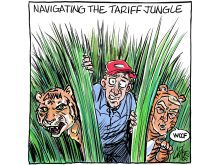This past week is likely to be typical of the next four years of chaos unleashed by U.S. president Donald Trump’s administration.
After much build-up, the tariffs on Mexico and Canada were delayed to March 1. The concessions by both Canada and Mexico were largely already promised by both governments in previous months.
Follow all our coverage of the tariffs situation here
Read Also

House ag committee to undertake several studies
The House of Commons standing agriculture committee has set its agenda for the coming months. Members began the fall sitting with a two-hour update on international trade
Equity markets cratered on Feb. 3 before the announcement of the 30-day reprieve. Markets immediately reversed course and ended the day by posting modest losses.
The primary reason for the delays was likely the losses in the stock market, which is one of Trump’s metrics that he follows closely. Be prepared for another cliffhanger at the end of the month.
It took no time at all for the president to introduce a new level of chaos on the way to the Super Bowl as he introduced steel and aluminum tariffs of 25 per cent on all countries, including Canada and Mexico. So much for a reprieve until March 1.
He also announced reciprocal tariffs on all goods. When the tariff rates differ between the United States and other countries, then the U.S. will apply a tariff to even the playing field. This will impact the Canadian supply managed sector in Canada.
It illustrates that predicting the future with the new U.S. government is an impossible task.
One of the factors that needs to be taken into account is the eventual goal of these tariffs.
One side views this as a negotiating position to pressure countries to lower their tariff barriers. This is where the market may be misreading the eventual outcome of the tariff war.
On the other hand, larger and more permanent tariffs may be in store for U.S. trading partners. Trump is convinced that tariffs are a slam dunk for improving the U.S. economy.
In his mind, tariff revenues will be used to offset the upcoming tax cuts that have been promised. This is where Canada, Mexico, China and the European Union should be cautious in the upcoming negotiations with the U.S.
The only way that the U.S. can gain enough money to partially offset the tax cut liability is to have broad-based tariffs on all of their major trading partners. It may not end up being 25 per cent, but it would still be substantial enough to damage the world economy, including the U.S.

















